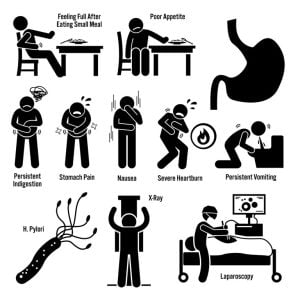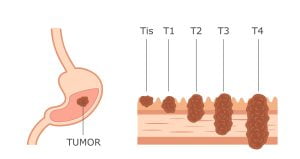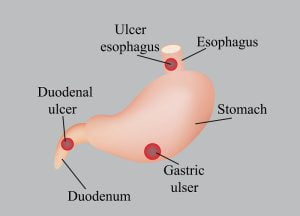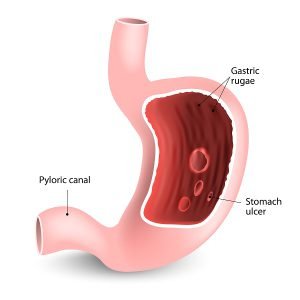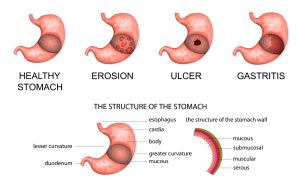Browsing: Stomach Cancer Graphics
Comprehensive Information, Resources, and Support on Stomach Cancer
The most common symptoms of advanced stomach cancer include nausea and vomiting, frequent heartburn, loss of appetite, constant bloating, early satiety, bloody stools, jaundice and stomach pain.
The stage of stomach cancer is determined using the TNM system. Tumor (T) determines spread of cancer into the stomach wall. Node (N) determines spread of tumor to the lymph nodes. Metastasis (M) determines metastases of cancer to other parts of the body.
When stomach cancer cells spread to liver, it is known as metastasized cancer or stage IV cancer. The identification of such cancer is very difficult. The cancer spreads to surrounding organs and complete cure is not possible at this stage. When stomach cancer spreads to liver, it is known as secondary cancer in the liver. Liver function tests are conducted for the diagnosis of secondary cancer in liver. To stop the stomach cancer from spreading, surgery or radiation therapies are recommended.
After diagnosis with cancer, the doctor determines the stage of your cancer. The stage of a cancer describes the extent to which cancer has spread in the body. It determines the severity of cancer, suitable treatment method and analyzes the survival statistics. Stomach cancer is quite treatable in early stages. However, early stomach cancer does not show significant symptoms and remains diagnosed. Usually, a diagnosis of gastric or stomach cancer is made when the cancer is more advanced. Therefore, only about 10% of people are diagnosed while it’s still in the early stages.
The two most common types of peptic ulcers are “gastric ulcers” and “duodenal ulcers”. Gastric ulcers are located in the stomach. Duodenal ulcers are found at the beginning of the small intestine, known as the duodenum.
Peptic ulcers are sores present in the lining of stomach, lower esophagus, or small intestine. They occur due to inflammation caused by H. pylori bacteria and due to erosion from stomach acids. Peptic ulcers are a common health problem.
Stomach is a muscular organ located on the left side of the upper abdomen. It secretes acids and enzymes to digest food. Ridges of the stomach muscle tissue called rugae lines the stomach and help in digestion. The main parts of stomach are antrum, cardia, fundus, body, pyrolus, duodenum, etc. Common diseases of the stomach are diaphragmatic hernia, acute and chronic gastritis, peptic ulcers, stomach tumors, carcinoma of the stomach and duodenum, etc.
Some of the most common symptoms of advanced stomach cancer are such as nausea and vomiting, frequent heartburn, loss of appetite, sudden unexplained weight loss. Other associated symptoms of stomach cancer are bloody stools, constant bloating, stomachache or pain in the breastbone, dysphagia, etc. It is observed that stomach cancer occurs when healthy cells within the upper digestive system become cancerous and the growth is uncontrollable. This might be due to some mutation in the cells which ultimately leads to formation of tumors. Several factors such as age, gender, genetics, lifestyle, H. pylori infections, etc aggravate the risk of stomach cancer.
ADVERTISEMENT




